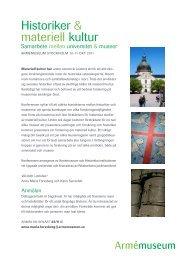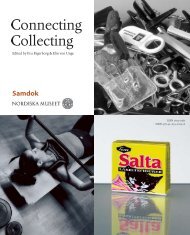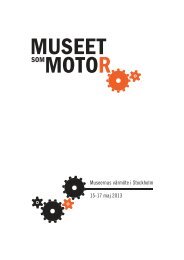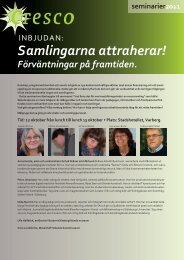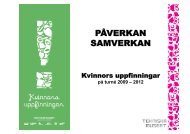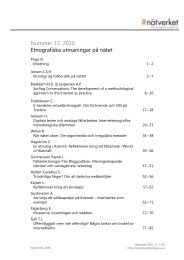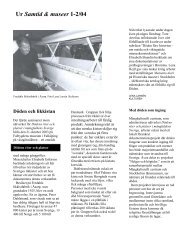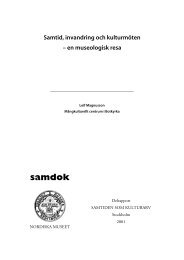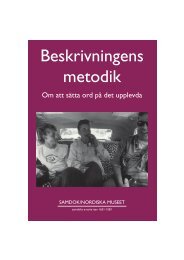Connecting Collecting - Sveriges Museer
Connecting Collecting - Sveriges Museer
Connecting Collecting - Sveriges Museer
Create successful ePaper yourself
Turn your PDF publications into a flip-book with our unique Google optimized e-Paper software.
The Pool for LeisureLeisure = spare time?Leisure life = lifestyle?Leisure ideals – for whom?the pool’s joint work is intended to raisethe level of activity among members bysustaining discussions and serving as aresource in ongoing work. Each membermuseum does studies in its own homeground, but the pool’s meetings are apossibility to ventilate and problematizetheir own studies. To elaborate on issuesof a theoretical and methodological character,we invite external lecturers andhold joint field seminars. The pool seeksdialogue not just with colleagues and researchers;just as important is the dialoguewith the general public. The Pool forLeisure also collaborates with the Poolfor Domestic Life.Work within Samdok is a way formuseums to collect contemporary narratives,photographs, and artefacts in athoroughly considered way. It is thereforean important part of the museums’present-day collecting work. Much ofthe material is used in exhibitions, programmes,and publications, thus makinguse of the collected material and obtainingresources for continued work.The pool’s member museums haverecently worked on projects to do withtopical social issues and themes concerningpeople on a personal level:Identity and its creationThe project Young People in a BorderDistrict, which Bohuslän Museum conducted2004–2006, is a Swedish-Norwegiancollaboration between museums,folk high schools, and the NordenAssociation (project Interreg III ASverige–Norge). The theme was youthand identity, border issues and conflictmanagement. What is Swedish and whatis Norwegian? What significance doesthe border have in today’s mobile society?The project marked the centennialof the break-up of the union betweenSweden and Norway in 1905, and soughtto examine how young people meet overthe border today. The results have beenpresented in theatrical performancesand exhibitions and a book has beenpublished to which young people contributedtheir narratives and thoughtsabout identity and identity creation.Meaningfulness – the good lifeWho is able to enjoy the good life? In theproject Just Like Rock and Roll, GothenburgCity Museum followed dancingcouples at Träffendansen in Kungälv.Here disabled and mentally retardedpeople meet once a month and dance tolive bands. A freshly qualified sociologistand a photographer in training werepresent at a number of dances. Theyphotographed and interviewed the participantsabout their views of dancing,socializing, and how to find a partner.Why do they find dancing so much fun?The aim was to bring out the pleasureand strength in a group that is otherwiseweak in the eyes of society. The projectresulted in an exhibition, and manydisabled people visited the museum forthe first time with pleasure, but othervisitors too felt pleasure (especially agroup of Japanese tourists who werehighly stimulated).An arena for entertainment orcreativity? The church town as acultural experienceIn northern Sweden the churches weresurrounded by houses where churchgoerscould spend the night. The longdistances that people had to travel to getto church were one of the reasons for thegrowth of these “church towns”. But howare the church towns used today? Theone in Skellefteå, known as Bonnstan or“Farmertown”, is ranked as Västerbotten’smost genuine church town and wasonce of great significance for social life.Today it consists of 116 houses with 392rooms which are privately owned. Theaim of Skellefteå Museum’s study is torecord contemporary life in a churchtown, and to find out through a questionnairesent to all the owners howthey use their rooms today. Three majorevents are held annually in Bonnstan, allof which attract thousands of visitors.The rest of the time the place offers opportunitiesfor relaxation, and the roomsare mainly used as meeting places forrelatives and friends, bringing picnicbaskets or holding parties to eat fermentedherring.Questions for the futureSweden today is a country with severaldifferent cultural identities – the traditionalSwedish leisure life is not a matterof course for new Swedes with a differentview of leisure. Taken-for-granted symbolsof leisure such as the holiday cottage,the evening class, and strolls in thecountryside may be totally alien to manypeople. The well-organized leisure that isprovided with public support is perhapsnot something that everyone wants totake part in.Other questions that the poolshould take up are who works to giveus “the good life”. What potential – inmoney and time – do they have forrewarding leisure time? The Westernworld with its quest for meaningfulnessand experiences is contrasted withwhat can be called leisure in other partsof the world. The different perspectivesthat characterize the view of leisure areimportant to bear in mind as the poolplans new studies and projects. It wouldbe fascinating to compare the practice ofleisure in Sweden with leisure in othercultures. pMarie Nyberg is curator at Gothenburg CityMuseum and chair of the Pool for Leisuremarie.nyberg@stadsmuseum.goteborg.seChristie Fredriksen is antiquarian at BohuslänMuseum, christine.fredriksen@vgregion.seSamtid & museer no 2/07 • 11



